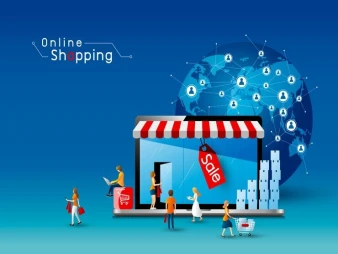Free support 24/7
Free support 24/7

Content strategy is the process of planning and implementing online content in a systematic and targeted manner to achieve specific goals, whether marketing, educational, or otherwise. Content plays a crucial role in building strong relationships with the audience and attracting more attention and engagement. Let's take a look at the stages and components of content strategy:
The first stage: planning and research
Before you start creating any content, you should define the main goals of your strategy. Do you want to increase traffic to your site? Are you aiming to boost your brand awareness? Do you want to increase sales of a specific product?
After setting goals, you should conduct extensive research to understand your target audience and their needs. You can use research tools like Google Keyword Planner and Google Trends to discover hot topics and related keywords.
The second stage: content creation
Based on the previous research, you can start creating content. Content should be useful and valuable to your audience, whether that's articles, videos, photos, blog posts, or any other form of media. Make sure the content is targeted, well-formatted, and aligns with your brand identity and message.
The third stage: content distribution
After creating the content, you must distribute it effectively. You can use social media, email, partner blogs, and search engines to publish content and increase its visibility. You should also determine the ideal time to post content based on the habits and schedules of your target audience.
The fourth stage: performance evaluation and improvement
Once content is published, you must continually monitor its performance. Use web analytics tools like Google Analytics to measure traffic and engagement. Review comments and feedback from your audience and leverage them to improve future content.
The fifth stage: preparing reports and measuring performance
To understand how well your strategy is achieving your goals, you should prepare regular reports to measure performance. You can use web analytics tools to track visits, conversion rate, and content interaction rate. Analyzing this data can help you determine whether you need to modify or develop your strategy.
The sixth component: organizing the chronology
A content strategy may include organizing a chronology of the content you will publish. This organization can be monthly or quarterly, and it depends on the nature of your work and your schedule. Organization helps maintain content continuity and deliver coordinated and sequential content.
Seventh Component: Interaction and Participation Strategies
Content strategy also includes how to enhance interaction and engagement from the audience. You can include polls, questionnaires, challenges, and contests in your content to increase engagement. Additionally, you can invite audience comments and participate in open discussions.
Component Eight: Search Engine Marketing (SEO)
Optimizing your content for search engines (SEO) is crucial to increasing your content's visibility in search results. Find relevant keywords and use them strategically in article titles, descriptions, image alt texts, and internal links.
Component 9: Managing comments and posts
Don't forget to make time to manage comments and shares on your social media platforms and site. You should respond to comments professionally and participate in discussions about your content. This helps build positive relationships with the audience.
Component 10: Customer Stories and Testimonials
Providing customer success stories and testimonials can be a powerful component of your strategy. These stories showcase how your customers benefit from your products or services, and build trust in your brand. You can incorporate these stories into your content through custom articles or videos.
Component Eleven: Scheduling and Content Management
Use content scheduling tools to effectively organize and manage the content production process. Create a schedule that identifies optimal posting days and times. This can help you avoid delays and ensure continuous content delivery.
Component Twelve: Monitoring and Surveillance
You should also monitor and monitor the performance of your strategy periodically. Web analysis reports and social media statistics provide live data about the impact of your content. Leverage this data to adjust your strategy and improve content performance.
Component Thirteen: Learning from competitors
Study the content strategies of your competitors. What topics do they cover? How does their audience interact with their content? You may find valuable ideas that you can apply in your own strategy.
Component Fourteen: Costs and Budget
Budget your strategy and control costs carefully. It should include production, distribution and promotion costs. Make sure your investment in content matches your goals and expected returns.
Component Fifteen: Improvement and Adaptation
Continue to improve your strategy based on performance and changes in the market. Make sustainable improvement of your content and your strategy as a whole part of an ongoing process. You may need to update your content regularly, make changes to your schedule, or focus on new topics.
Component sixteen: Commitment to quality
Quality is the key to a successful content strategy. Make sure your content is credible, reliable, and has the right information. Avoid rushing content creation and stay away from misleading or inaccurate references.
Component seventeen: Structure and organization
Within your strategy, you should also establish a logical structure and organization of the content. This makes it easier for readers or viewers to understand the content and find the information they are looking for. Use internal promotions and relevant links to direct the audience to other related content.
The eighteenth component: diversity in shapes and types
Content strategy is not limited to one type of content. Try a variety of formats and genres, such as articles, videos, podcasts, graphics, and more. This can increase the appeal of your content to a diverse audience.
Component
Nineteen: Thinking about the future
The evolution of technology and audience behavior over time. So, always think about the future and how to adapt your strategy to these changes. Updating your skills and knowledge with the latest developments in the field of content strategy can bring significant benefits.
Component Twenty: Commitment to values and ethics
Ethics and values play an important role in content strategy. Make sure your content aligns with your brand values and ethical principles. Avoid posting content that could be offensive or harmful to the public.
Component Twenty-one: Providing added value
Content that provides added value to the audience is the most attractive. Always try to provide useful and detailed information, solutions to problems, and practical guidance. This will make your audience trust your brand and consider it a reliable source.
Component Twenty-Two: Interaction with the Public
Engaging with your audience is an important part of content strategy. Respond to their comments and questions on a regular basis, and try to build a relationship with them. Strong relationships with your audience can lead to loyalty and continued engagement.
Component Twenty-Three: Listening to the audience
Don't just be a talker, be a listener. Leverage analytics tools and audience surveys to better understand their needs and requirements. This will help you guide your strategy and improve your content further.
Conclusion
Content strategy is a complex process that requires serious thought and planning. Using the above components and tips, you can build a comprehensive and effective content strategy that will help you achieve your goals and the success of your online business. Remember, a commitment to continuous development and responding to your audience's needs can be the key to success in this field.

Flash sales are not just a temporary marketing tool. They are a smart tool to quickly drive sales and increase engagement in your store

تعرف على الطريقة الذكية اللي تخليك تستفيد من تجارب عملاءك السابقين في تسويق منتجاتك الجديدة وزيادة المبيعات
You can create your store easily